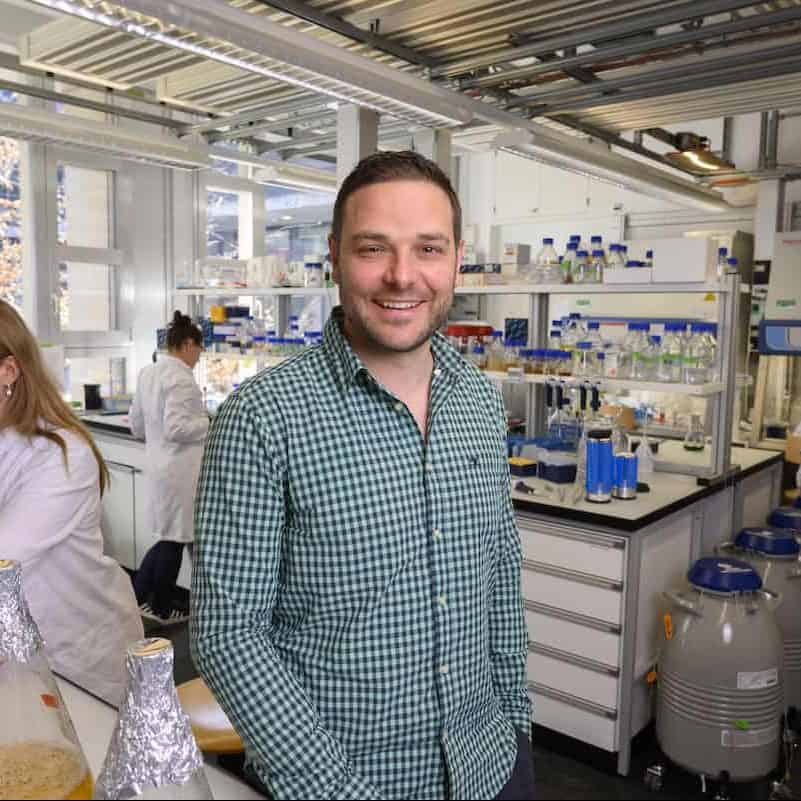The work of NOMIS researcher Martin Pilhofer, who holds the NOMIS-supported Professorship of Cryo-Electron Microscopy at ETH Zurich, was profiled in an article in Uplift, an ETH Foundation magazine. Pilhofer’s research explores the evolution of single-cell organisms. The article follows:
The goal set by Martin Pilhofer and his team is to find out how microscopic living beings – so-called microbes – interact with other cells. He’s particularly interested in investigating the structures that mediate these cell–cell interactions. By combining cryo-electron microscopy (cryo-EM) with other imaging techniques, the group can link findings ranging from the molecular to cellular and intercellular levels. This means that data sets from light microscopy provide information in the micrometre range, while methods from structural biology – which is where cryo-EM comes in – provide insights at atomic level in the nanometre range and below.
In cryo-EM, cell samples need to be prepared before they can be examined under the electron microscope. This is achieved with a process that stabilises the samples using a flash-freezing technique. Pilhofer made significant improvements to this technique during his research stay in the USA and, in 2014, brought it to ETH, where he was appointed assistant professor and then associate professor. As a result, another key aspect of the group’s work, besides its research into various cell-cell interactions, is further developing cryo-EM.
How everything began
Martin Pilhofer’s professorship is one of four in the Department of Biology affiliated with the Centre of Origin and Prevalence of Life. Its creation was made possible by donors that included the NOMIS Foundation; similarly, the team is able to work with the very latest cryo-EM equipment thanks to the Baugarten Stiftung and August von Finck family.
In his research conducted within the context of the interdisciplinary centre, Pilhofer is studying the evolution of single-cell organisms. He says: “The further back we go in Earth’s history, the more uncertain our hypotheses and findings become.” Even the emergence of the first single-celled organisms cannot be precisely determined. Based on evidence provided by fossil bacteria, it’s estimated that they appeared around 3.5 to 4 billion years ago. “We assume that in extreme places such as deep-sea vents or hot springs, the original single-celled organisms split into bacteria and archaea soon after their emergence,” the microbiologist says.
Pilhofer and his group are now making high-resolution electron microscopy images of so-called Asgard archaea. The ETH researchers want to find out what the cell membrane of the Asgard archaea looks like and whether there’s a special inner membrane system in these cells. “This research helps us to better understand how a host cell that fused with a bacterium then developed into a complex cell,” Pilhofer says.
Interesting funding opportunities
Martin Pilhofer’s research contributes important pieces to the puzzle of the origin of life. But many are still missing. For the Centre for Origin and Prevalence of Life to leverage its full potential, further financial backing from donors, foundations and industry is required. In the current phase, funds are particularly needed to provide early-career researchers with support – like fellowships for doctoral students, for example.
“Many research groups from different ETH departments have one thing in common: the great desire to understand the origins of life. By setting up the Centre for Origin and Prevalence of Life, we’ve created the best environment possible to transform this collective interest into collective answers.” —Joël Mesot, President of ETH Zurich, Vice Chair ETH Foundation Board of Trustees
Go to this ETH Foundation article



